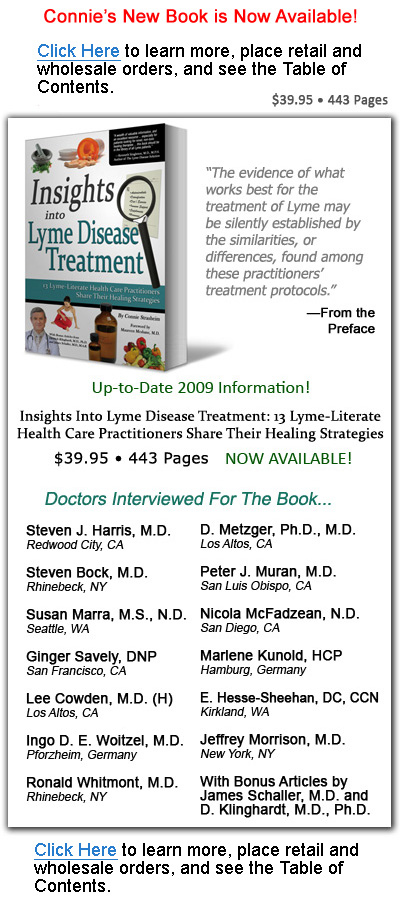Welcome To Lyme Bytes!
April, 2014- HELLO ALL! I am no longer posting to this blog. For the latest on me and my work, I invite you to subscribe to my NEW blog: www.conniestrasheim.blogspot.com where I share my latest findings on how to heal from chronic illness involving Lyme and other conditions. Thanks!
Greetings and welcome to my Lyme disease blog, a comfy cozy (and sometimes crazy!) place for cutting-edge information, encouragement and insight into the fastest-growing epidemic disease in the United States. In this blog you will find everything from bug-killing strategies to immune system and hormone help, as well as lifestyle and spiritual suggestions for healing from chronic illness involving Lyme disease. The information contained within this blog is based upon my own healing journey and what I have learned over the past eight years as I have been diligently digging and researching my way back to a better state of health. May you find it to be a source of hope, inspiration and wisdom in your own journey towards wellness.
About "Insights Into Lyme Disease Treatment"
About the book:
Published August, 2009
Written by Connie Strasheim
Learn More - Bulk Orders - Table of Contents
Saturday, April 19, 2008
Lyme And Links To Autism
Sorting out whether an autism patient has Lyme disease can be difficult, however. Since tests for Lyme disease are often inaccurate, physicians must base their diagnoses upon clinical evaluation, and this can be difficult when many similarities can be found between those with Lyme disease and those with autism (Never mind those autism patients with Lyme disease)!. For instance, chronic bacterial and viral infections, especially HHV-6 and strep, are prevalent in both conditions. Amino acid and mineral imbalances are high, anemia is common, as are high levels of heavy metals. Most confounding are neurological symptoms, which can be similar, and temporal lobe brain deficits and oxidative stress, resulting in atrophy of the cerebellum, are common. Detoxification mechanisms are often compromised. In addition, Lyme and autism parallel one another in bizarre, and/or dysfunctional immune processes. High levels of tumor necrosis factor, low NK (killer cell) counts, oxidative stress, susceptibility to viruses, microglia activation and the production of antibodies to neurons, as well as other auto-immune processes, are found in both conditions.
Healing from autism involves using some of the same nutritional and supportive strategies as those used for Lyme disease, and where Lyme disease is a factor, even more so. But because autism is a broad-spectrum disorder, the treatments used for Lyme disease may only result in partial recovery from symptoms of autism. Every autism patient is different, but for those for whom Lyme disease is a problem, treatment of the Lyme complex can result in significant improvement to the autistic person's overall symptom picture.



No comments:
Post a Comment